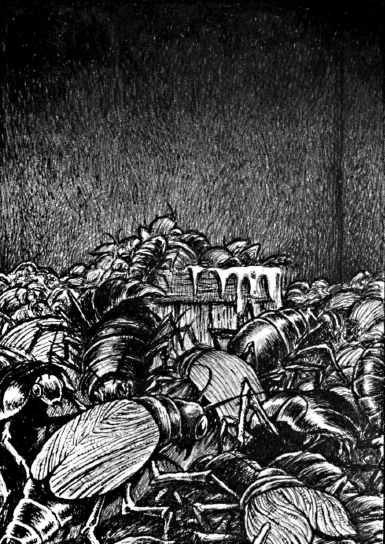How did I come to this, you might ask? Good question. Lately, as you may have noticed, I’ve been focusing a lot on Warmaster (Revolution), and after wrapping up the Vampire Counts project, I decided to delve into Kislev. All fairly straightforward up to this point… you start a project and then, as they say in Italy, “appetite comes with eating.” While searching for inspiration for the palette, I stumbled upon the old cover of Something Rotten in Kislev (SRIK), the penultimate book of the legendary Warhammer Fantasy Roleplay Imperial Campaign (TEW). Obviously, there’s no need for me to emphasize that I’m exclusively referring to the first edition, right? Good. Now, as I revisited the notes from the campaign that I’ve played and run several times (4), I noticed that the general opinion on this module is quite cold within the WFRP community. I understand it… indeed, compared to Power Behind the Throne and Death on the Reik, the narrative structure is weaker, but downgrading the content of the entire book to “rubbish” just because it’s not “canon,” in my opinion, is also getting lost in the puritanism of the early modules and rejecting an alternative and “fresh” vision. Let me explain better: It’s evident that SRIK was forcefully inserted into the timeline of the Imperial Campaign (TEW), but what I find very, very interesting lies in the themes and the originality of the situations in which the heroes find themselves, which, in my opinion, are very, very close to the dark humor that permeates the entire TEW.
The ancient, forgotten beings, like those presented in THE BEAST CHILD, toy with the lives of adventurers as if they do not comprehend the extent of their power and mortality in the eyes of common mortals, isolated in their open-air prison near the forests of the remote VOLTSARA. The swan song of the ancient religions, eradicated by the new ones… am I the only one who sees a lot of dramatics in this? It reminded me greatly of the end of the Greek gods with the arrival of Christianity, in this case embodied by chaos. I understand that the tone of the adventure is very different from what those who have played the previous modules of the TEW expect, but don’t tell me that Schloss Wittgestein and/or Etelka Herzen’s goblin assistant lack a sense of cheap irony.


Sure, it’s “contextualized” within the module, but even the forgotten gods of VOLTSARA are an expression of the changing times unfolding in Kislev… Let’s continue with two adventures that I personally find brilliant in the paradox they pose to the characters: CHERNOZAVTRA and BOLGASGRAD. Hobgoblins besieging “good” undead? What screams WFRP more than this? Necromancy being reinterpreted in a pragmatic light, putting the characters in a deontological dilemma regarding the actual “evilness” of those who use it, or those who are enslaved to forgotten chaos gods? Personally, I find a great deal of philosophy in these two adventures. The challenge here is not to exterminate the party in a frontal encounter like at Schloss Wittgestein, but it’s much more subtle: it puts into crisis three classes/races that likely have come this far into the module: the cleric, the dwarf, and the wizard.

The challenge, in my opinion, lies in combating within the party the dogmatic figures, challenging the characters in their relationships rather than facing the enemy head-on: try negotiating with a dwarf in the party alongside hobgoblins, or perhaps worse, try negotiating with a Chaos god with a Sigmarite priest by your side… and what about a wizard who discovers that necromancy isn’t absolute evil, but merely a tool that could potentially be used for good? In my view, the true challenge of SRIK is precisely stated in the module’s title: creating “wounds” within the party that can poison their relationships and ultimately kill them through self-destruction. The adventures, as I interpret them, aim to bring the most radical members of the party into conflict with the wiser ones, forcing their hands and attempting to destroy the party from within, pitting them against each other. Furthermore, I’d add that SRIK casts a glance at a part of the world that WFRP has always left aside: Gnomes, the farthest east, Forgotten Gods, Hobgoblins… there’s no other module that allows for such a wide variety of themes.

Is it funny? Yes, in the way WFRP can be, exactly like playing Russian roulette. Make one wrong move, and you’re dead in all three sub-adventures. Ridiculous? No, absolutely not. Do I need to remind you of the werewolf in Restless Dead? I’d say SRIK isn’t the worst, but the people who played it couldn’t get past the canon of TEW and experienced it like a bad dream, completely missing the approach to this module. Morally, for me, Something Rotten in Kislev is absolutely pivotal in TEW.


Well, I come to this tabula rasa. When we played 1e TEW I’d have said Kislev was my favorite chapter. Not “canon?” Maybe not now (and news to me), but they can bite me. It was amazing.
LikeLiked by 1 person
Amen!
LikeLike
I had LOTS of fun with that chapter of the Campaign.. but yeah, I’d rather have it as something else than in the Imperial Campaign. You could actually make a whole campaign there… of use it AFTER 1000 thrones…
LikeLiked by 1 person